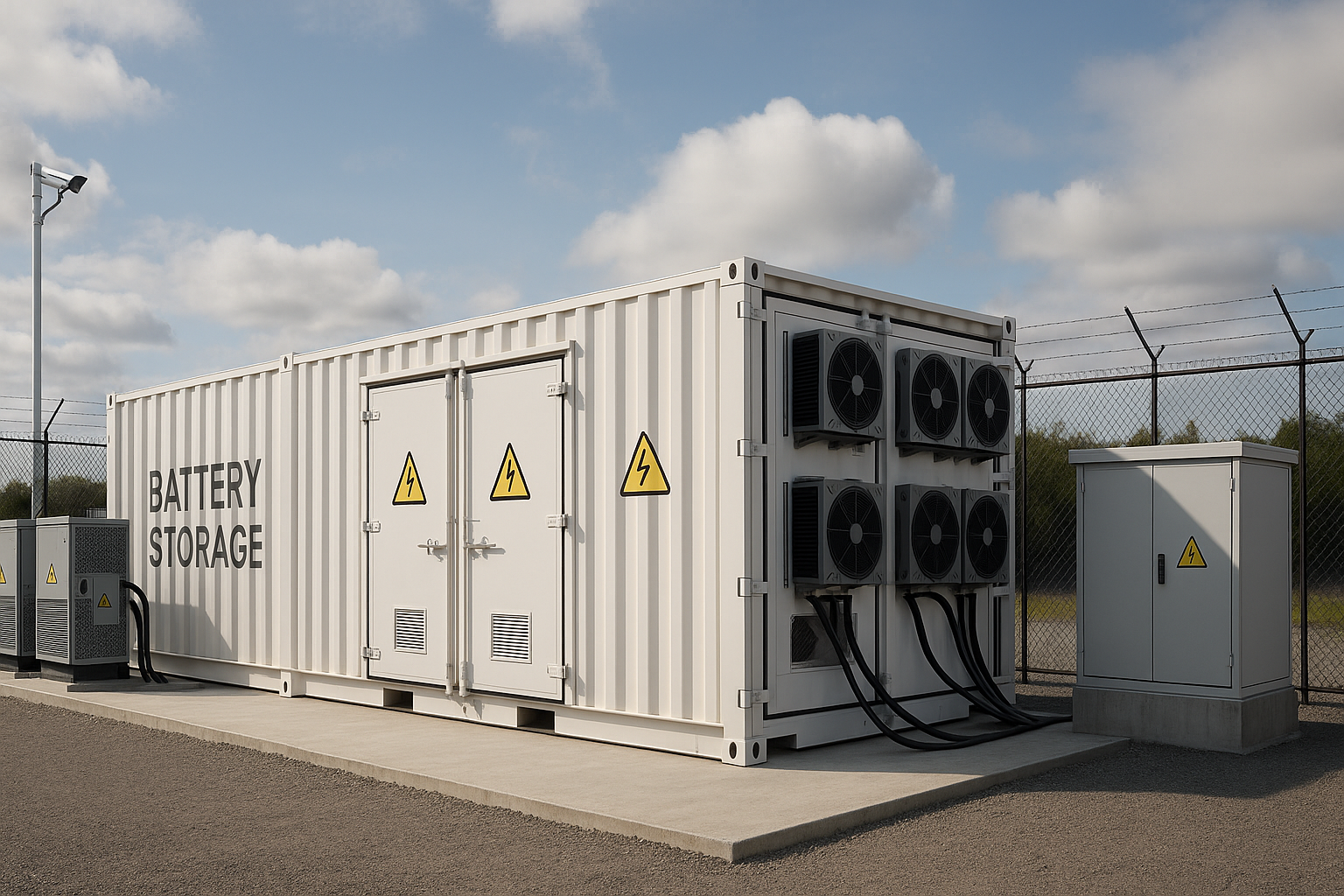
Welcome to this edition of Learning of the Week. This is the second edition of our BESS newsletter series. Last time, we traced the battery’s journey from a pocket-sized invention to a grid-scale game changer. This week, we’re getting under the hood and will discuss the following:
1. Components that make up BESS?
2. How a full-scale BESS project look like?
3. How long can a BESS power the grid?
4. How much does it cost?
5. What makes BESS viable now?
Let’s unpack everything layer by layer, one at a time. But before diving in let’s refresh the basics:
Refreshing Basics
Till now, we understood that BESS is a large, intelligent system designed to store electricity when there’s surplus and release it when there’s a deficit. It stores energy from sources and delivers that electricity back to the grid during periods of high demand or when enough power production is not taking place. BESS stores excess electricity and holds it until it’s needed.
CORE Components that Power BESS
In the previous letter, we covered that BESS is a coordinated system of electrical, thermal, digital, and mechanical components that work together seamlessly. Today, we’ll get a layer deeper and talk about the components that power BESS and their job in this entire system.
1. Battery Cells & Racks
Battery cells (the heart of BESS) are the most prominent part of BESS; typically Lithium-ion. The set-up is organized in a layered structure: cells are the smallest unit, grouped into modules, which are then assembled into larger packs equipped with sensors and cooling systems. While each cell may seem small on its own, together they form the powerhouse of the entire system.
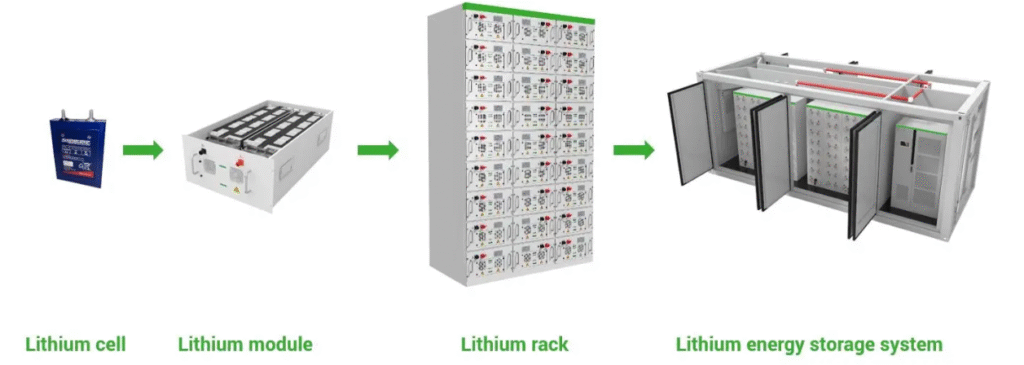
(Source: EVESCO)
2. Power Conversion System (PCS)
In a Battery Energy Storage System (BESS), electricity is stored as Direct Current (DC), but our homes, industries, and the electrical grid primarily operate on Alternating Current (AC). To bridge this gap, a Power Conversion System (PCS) or hybrid inverter plays a vital role. Think of PCS as a more advanced version of a basic inverter, as it converts electricity in both directions: DC to AC for supplying energy to the grid, and AC to DC for charging the batteries.
3. Battery Management System (BMS)
If the battery cells are the heart of a BESS, the BMS is undoubtedly the brain. It plays a crucial role in ensuring that every cell inside the battery pack functions safely, efficiently, and within its design limits. The BMS is a software that constantly monitors two things: a) State of Charge (SoC) of each cell, essentially how “full” or “empty” it is, and b) State of Health (SoH), which reflects the long-term condition and degradation of each cell over time. Basically, the BMS records key parameters like temperature, voltage, and current flow across individual cells and modules.
In addition to this, when abnormalities such as overheating, overvoltage, or uneven charging are detected, the BMS intervenes in real-time. Interventions are in the form of a reduction in charging speed, shutting down affected modules, or activating cooling systems, etc. Below is a visual representation.
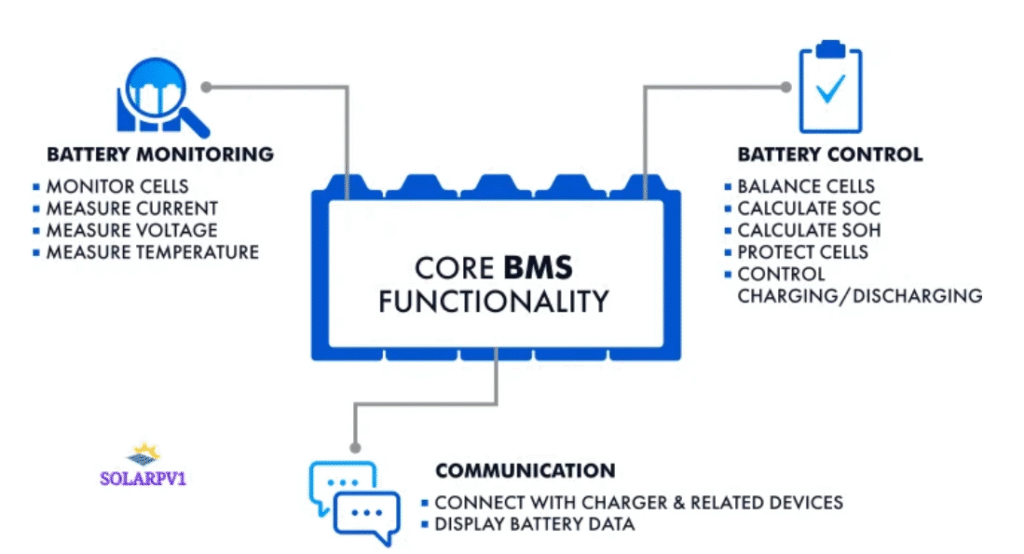
(Source: SolarPV1)
4. Energy Management System (EMS)
So far, we have talked about the heart (battery cells) and the brain (BMS) of BESS. Now, it’s time to talk about the strategist of the entire system, the Energy Management System (EMS). Consider it as a controller that monitors everything and makes decisions in real-time; when to charge, when to discharge, how much power to store, and how much to release into the grid.
Unlike the BMS, which looks inward at SoC and SoH, EMS looks outward and continuously analyzes external factors like electricity prices, grid demand, energy availability, weather forecasts, etc. Using this data, it optimizes the system to deliver the most value; financially and operationally. In more advanced setups, EMS platforms use AI algorithms and predictive analytics to plan and automate these decisions with remarkable accuracy. Below is a visual representation.
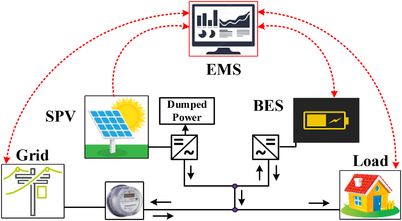
(Source: Researchgate)
5. SCADA (Supervisory Control and Data Management) System
In simple terms, SCADA is the dashboard for BESS. It doesn’t make decisions, but it shows you everything that’s happening inside in real-time. It helps operators to monitor the health of the system, track performance, log data, and respond to alerts. SCADA gives visibility into every component: batteries, inverters, cooling, safety systems, etc. Just like a control room with cameras, meters, and switches, it just keeps everything connected, enables monitoring, and recording.
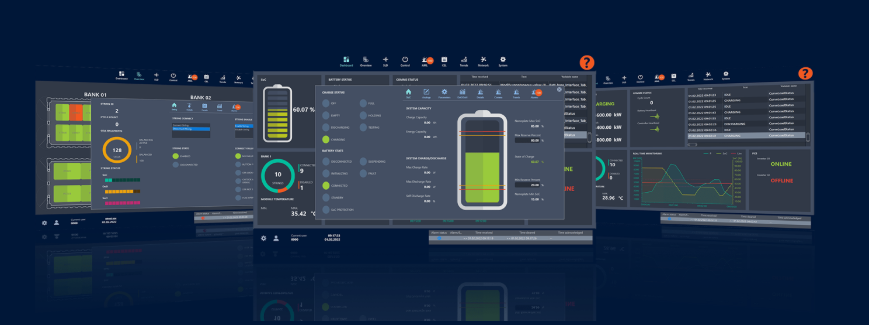
(Source: Copadata)
6. Thermal Management and Safety Systems
Batteries operate best within a narrow temperature band; too much heat or cold can degrade performance, shorten lifespan, or even pose safety risks. To maintain this balance, BESS installations have advanced cooling technologies such as liquid cooling, forced air systems, or integrated HVAC setups. These ensure that the battery cells stay in their optimal thermal range, even during intense charging or discharging cycles.
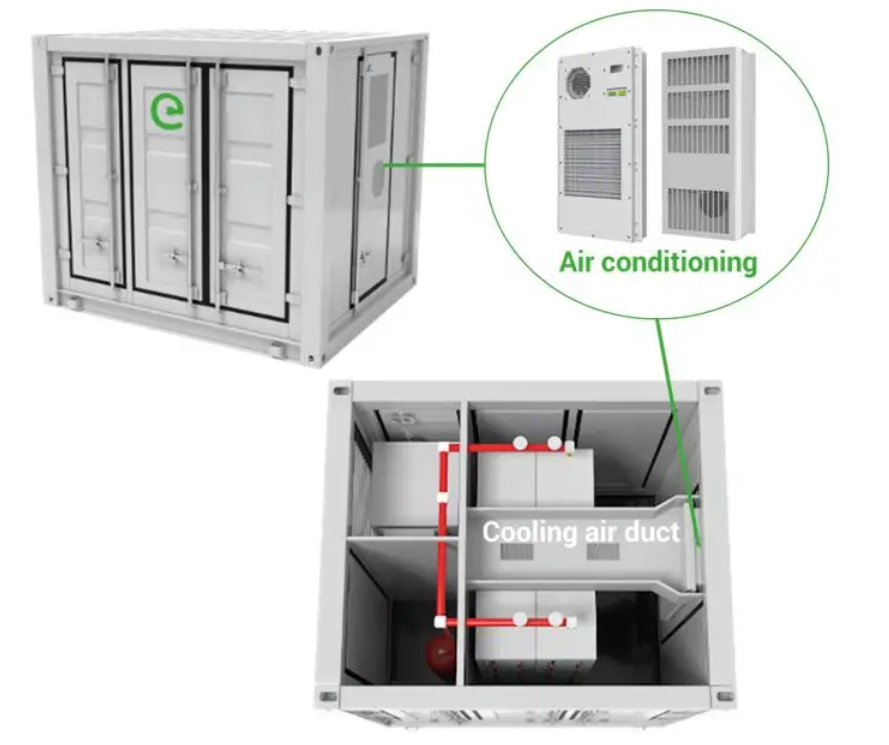
(Source: EVESCO)
Complementing this is a dedicated fire suppression system; the ultimate failsafe. Equipped with smoke detectors, thermal sensors, and gas or aerosol extinguishing agents, it’s designed to detect anomalies early and respond before they escalate. Together, these systems don’t just safeguard the battery but ensure reliability, longevity, and peace of mind for operators and users alike.
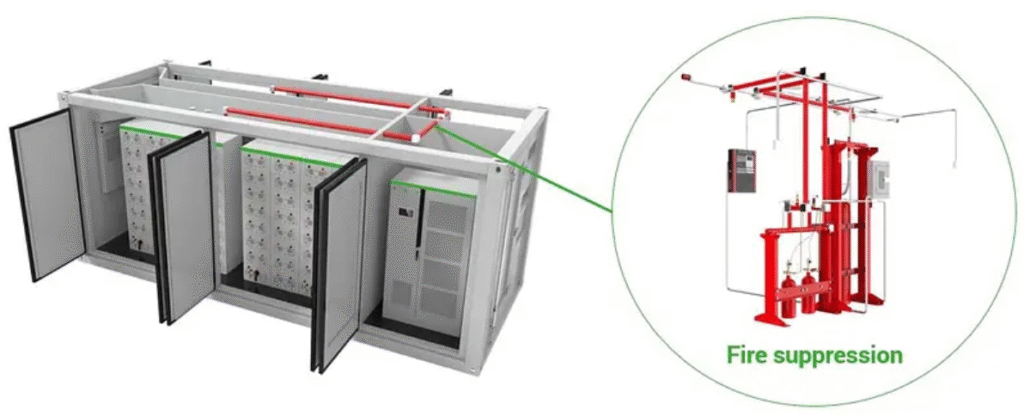
(Source: EVESCO)
7. Communication Interface
The communication interface comes in when BESS need to talk to the outside world. Think of it as the translator and the telephone line of the entire system. While SCADA helps monitor what’s happening inside, the communications interface connects the BESS to everything outside;the utility grid, renewable sources, and control centers. It uses special “languages” or protocols like Modbus or IEC 61850 to ensure smooth communication between the BESS and grid operators. This link allows the system to receive signals (like a demand spike) and respond accordingly.

(Source: Moxa)
But, How does it look? Is it a Giant Machine or a Giant Battery Sitting Somewhere?
Given the progression we have followed, this is a natural question that pops up. Imagine standing at the edge of a quiet, fenced-off site on the outskirts of a city. In front of you, there are a few long containers; ordinary at first glance, but inside them sit rows of powerful battery racks, storing clean energy like digital reservoirs.
Beside them are the inverters (metal cabinets) converting power back and forth between the grid and the batteries. Step closer, and you’ll see pipes, vents, and cooling fans regulating temperature because batteries don’t like extremes.
Tucked in smaller units are the real brains: control systems that make split-second decisions on when to store, release, or hold back power. Thick cables disappear underground, connecting the entire system to nearby transformers and into the main grid. No noise, no moving parts, just silent infrastructure, balancing energy behind the scenes, ready to respond when the grid calls. This is how a BESS Setup looks:
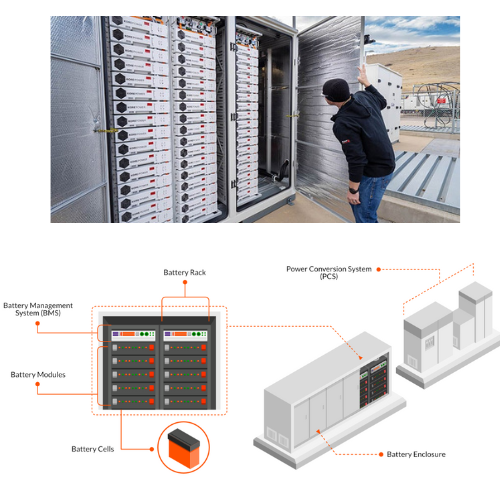
(Source: Werner Slocum / NREL; lightsourcebp)
Tell me how long can these Giant Battery Racks keep the Lights on?
When we talk about the capacity of a particular BESS system, it is crucial to talk about the following TWO variables:
a) POWER OUTPUT (in MW) – The rate at which energy flows to the Grid
b) ENERGY STORED (in MWh) – The total storage capacity of the setup
Think of it like a water system; power output is the flow rate from the tap (how fast electricity is delivered), while energy stored is the size of the tank (how long that flow can last). Therefore, the simple answer to the above question is that the duration of the system being able to keep the lights on depends on the above two variables.
Most systems today are designed for short-duration support like managing evening peaks, balancing the grid, or providing backup during brief outages. But the scale is evolving fast. Newer systems are being designed to store and release energy for 6 to 10 hours or more, especially in places relying heavily on solar and wind.
The cost of a BESS project goes up as the ENERGY STORED increases
When a BESS is sized, POWER is the first thing to be defined based on the grid service or load requirement. Once the power conversion system (PCS), cabling, transformers, and switchgears are in place for that power rating, those components don’t usually change if one plans to extend the duration.
It is the ENERGY STORED that drives most of the cost increase. Battery Racks is what determine total energy storage capacity. Therefore, to go from 2 hours to 4 hours at the same power rating, you double the number of cells, and as you know, doubling battery pack costs. In summary, PCS, installation, and most soft costs don’t scale in the same proportion; they are largely fixed for a given MW rating.
To understand this better, let’s say we have a 50 MW BESS. Now, based on the duration for which you need backup, the following energy storage scenarios can be created:
– 2-hour duration → 50 MW × 2 hours = 100 MWh
– 4-hour duration → 50 MW × 4 hours = 200 MWh
– 6-hour duration → 50 MW × 6 hours = 300 MWh
In short, Power (MW) stays the same. Energy (MWh) increases with longer durations. That extra energy capacity comes from more batteries; which means higher costs.
Based on current studies, a 2-hour discharge system costs ~Rs 1.3 Cr per MWh, a 4-hour system costs ~Rs. 1.8 Cr per MWh, and a 6-hour system comes in at ~Rs. 1.9 Cr per MWh. As duration goes up, battery cells dominate costs increases more; since more energy is being stored. Whereas, the share of power conversion system (PCS), cabling, transformers, and switchgears drops. Following numbers will help solidify the understanding further:

Why has BESS become a Winning Solution Today?
Much like the journey of solar panels over the last decade, battery storage technology has also seen a dramatic drop in costs, making it more viable, scalable, and attractive than ever before. As of 2024, the average global price of lithium-ion battery packs has fallen to just $115 per kWh. That’s a 20% drop in just one year, and a staggering 84% reduction compared to prices a decade ago. These declining costs are a game-changer, making large-scale energy storage projects not just technically feasible, but also economically compelling. It’s no longer a futuristic concept. Battery storage is now a commercially sound solution for clean, reliable, and responsive power systems.

(Source: Werner Slocum / NREL; lightsourcebp)
Conclusion
In this edition, we stepped inside, breaking down the BESS system into pieces to understand how this intelligent storage system really works. How each component plays a role, and together they turn a static box into a dynamic, grid-ready asset. This isn’t just storage; it’s infrastructure. A solution that adapts, scales, and responds in real-time. Gradually, BESS is shifting from emerging to essential.
Up Next…
By now, you’ve seen BESS in action, not just as a battery, but as a full-fledged energy system. We walked through its brain-like control systems, its physical structure, how long it can keep the lights on, what it costs to build one from scratch and what makes it viable now. In the next editions, we’ll dive deeper and strengthen our understanding of BESS. Stay with us…
If you enjoyed reading this newsletter, please feel free to share it with others who might find it insightful. We’d also love to hear your thoughts and feedback on X. Connect with us there at @bastionresearch.
Happy Investing!!!
😂Meme of the Week🤣





